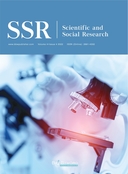Optimization Strategy of Comprehensive Evaluation Method Based on Relative Excellence Measure
Abstract
Aiming at the comparison and optimization of comprehensive evaluation methods, this paper proposes an optimization strategy of comprehensive evaluation method and constructs a relative excellence measure of the comprehensive evaluation method based on the deviation of rating value and Spearman grade correlation coefficient. On the basis of the relative excellence measure, combined with the compatibility test, the optimization strategy of the comprehensive evaluation method is given to realize the optimization of the comprehensive evaluation method. Finally, the feasibility of this strategy is verified by a case.
References
Yi P, Li W, Guo Y, 2019, Comprehensive Evaluation Theory and Method, Economic Management Press, Beijing.
Chen G, Chen Y, 2002, Proceedings of 2002 International Conference on Management Science & Engineering, August 18-20, 2002: The Research Progress & Development Trend of Comprehensive Evaluation Methods. Harbin Institute of Technology Press, Harbin.
Chen G, Li M, 2004, A Study on the Measurement of Driftability of Single Method Evaluation. China Engineering Science, 6(3): 58-63.
Cooper WW, Wei Q, 1997, Using Displaced Cone Representation in DEA Models for Nondo-Minated Solutions in Multiobjective Programmming. Systems Science and Mathematical Sciences, 10(1): 41-49.
Zhang Z, Chen G, 2002, Proceedings of 2002 International Conference on Management Science & Engineering, August 18-20, 2002: The Analysis on Efficiency of Input-Output of Science and Technology Using Improved DEA Model. Harbin Institute Technology Press, Harbin.
Zhang Q, 2001, Difference Information Entropy in Grey Theory. The Journal of Grey System, 13(2): 111-116.
Manoliadis OG, Pantouvakis JP, 2003, Proceedings of the 2nd International Conference on Structural and Construction Engineering, September 23-26, 2003: Multicriteria Decision Support Systems in Engineering Planning and Management. System Based Vision for Strategic and Creative Design, Rome.
Zhang L, Wang Y, 2011, Research on Measurement Method of Relative Effectiveness of Comprehensive Evaluation Model. Statistics and Decision Making, 2011(20): 18-21.
Wang Q, 2003, Comparison of Several Conventional Comprehensive Evaluation Methods. Statistics and Information Forum, 2003(02): 30-33.
Niu X, Zheng S, 2006, Comparison of Several Conventional Comprehensive Evaluation Methods. Statistics and Decision Making, 2006(05): 142-143.
Research Group of Natural Science Foundation of Hangzhou Business School, 1996, “Sum of Serial Numbers Theory” and Its Application in the Ranking of Comprehensive Economic Benefits. Research on Quantitative Economy and Technical Economy, 1996(01): 59-62.
Jia P, Li X, Wang J, 2008, Comparison of Several Typical Comprehensive Evaluation Method. China Hospital Statistics, 15(04): 351-353.
Chen X, 2004, Empirical Comparison of Several Comprehensive Evaluation Methods. Journal of Jiangxi University of Finance and Economics, 2004(03): 20-23.
Bai X, Zhao S, 2000, Research on Judging the Advantages and Disadvantages of Various Comprehensive Evaluation Methods. Statistical Research, 2000(07): 45-48.
Sun S, Qiu Z, Zhang X, 2006, Research on Simulation Method for Robustness Evaluation of Multi-Attribute Decision Making. Journal of Wuhan University of Technology (Information and Management Engineering Edition), 2006(12): 58-61.
Zhang F, Hua W, Li Y, 2019, Stability Analysis of Several Comprehensive Evaluation Methods. Systems Science and Mathematics, 39(04): 595-610.
Chen G, Li Me, 2005, Computer Simulation Experiment of Convergence Verification of Combinatorial Evaluation. System Engineering Theory and Practice, 2005(05): 74-82.
Song J, Zhao Z, Zhang Y, et al., 2020, Research on Enterprise Competitive Intelligence System Evaluation Under the Background of Big Data. Journal of Intelligence, 39(8): 182-192.
Guo Y, Ma Z, Zhang F, 2009, Relative Effectiveness Analysis and Application of Combination Evaluation Method. China Management Science, 17(2): 125-130.
Li M, Chen G, Xu L, et al., 2015, Research on Dynamic Combination Evaluation Method Based on Drift Degree. China Management Science, 23(1): 141-145.

